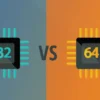
All types of computer memory play crucial roles in powering our computers. Just like the human brain employs diverse memory systems, computers too utilise a range of specialised memory types, each with its unique purpose, functions and characteristics. Now, let’s delve into these essential components that fuel our digital companions.
All types of computer memory

All types of computer memory
Computer memory serves as a fundamental component of the system, integral for executing even the simplest tasks. Memory serves as a storehouse for various forms of data, such as documents, photos, music, and video, within the computer framework, guaranteeing its accessibility when needed.
also Guided by user commands, the CPU(computer’s central processor)orchestrates the interaction with memory cells, facilitating the retrieval and modification of data relevant to the desired task. All types of computer memory are tailored to meet the unique requirements of various devices.
Different types of computer memory
Let us now discuss the classification of all types of computer memory. Broadly, memory is segregated into Primary, Secondary, Cache and Virtual. Further classification is between primary and secondary memory.
Primary Memory
Primary memory is a computer’s memory that is accessed first or directly by a processor or computer.
It permits a processor to access programs and services that are now running and have been momentarily stored in a designated memory. The term “primary memory” may also refer to “primary storage” or “main memory.” Because it is a volatile memory too, any data that hasn’t been stored gets erased in the event of a power outage. RAM and ROM are the two forms of primary memory.
RAM
Random-access memory is commonly referred to as RAM in computer terminology. It may be referred to as PC memory or just memory. Essentially, RAM serves as the short-term memory of your computer or laptop. It holds the data required by your computer processor to execute applications and access your files.
ROM

All types of computer memory
Read-Only Memory, or ROM, is a kind of computer memory that stores information permanently. It resembles an inflexible, built-in storage system. also Essential data or instructions, such as the fundamentals for booting up a computer, are programmed into RAM by manufacturers during production. ROM retains its data even when the computer is turned off, in contrast to RAM, which erases everything.
Secondary Memory
Secondary memory, also called secondary storage, is like a computer’s long-term memory. It is accessed indirectly via input/output operations. Secondary memory stores data even when the computer is turned off, unlike RAM, which forgets everything when the power is off. It’s where you keep things for the long haul, like documents, programs, and pictures. You can still access this stored information even after restarting the computer.
Some of the secondary memory or storage devices are listed below:
- Hard Disk Drives(HDDs): Are conventional storage devices that rely on spinning magnetic disks to hold data. They provide extensive storage space at a reasonable price. While great for housing vast data collections, they don’t match SSDs in terms of speed.
- also, Solid-State Drives (SSDs): SSDs use flash memory chips to store data, resulting in faster access times compared to HDDs. They are more durable and energy-efficient than HDDs but are typically more expensive per gigabyte.
If we delve deeper, we’ll find additional types of secondary memory, such as optical discs like CDs and DVDs, memory cards for cameras and smartphones, and even cloud storage solutions.
Read more: How to Download Photoshop programs?
Conclusion | All types of computer memory

All types of computer memory
In summary, understanding primary and secondary memory, which are two of all types of computer memory, sheds light on how computers work.
These memory types are like the backbone of digital devices, handling tasks and storing data. Primary memory quickly manages immediate needs, while secondary memory stores lots of information for the long term.
Cache and virtual memory also help boost performance and capacity, supporting primary and secondary memory. Together, these components make up all types of computer memory, essential for everyday digital tasks.




